Key takeaways:
- Homelessness is a complex issue intertwined with emotional, psychological, and financial factors, necessitating holistic solutions from charities.
- Effective petitions can drive change by raising awareness, fostering community dialogue, and connecting personal stories with statistics.
- Engaging supporters requires emotional connections through storytelling, creativity, and consistent communication to maintain enthusiasm and participation.
- Challenges in petition campaigns highlight the need for perseverance, success narratives, and collaborative efforts with other organizations to amplify impact.
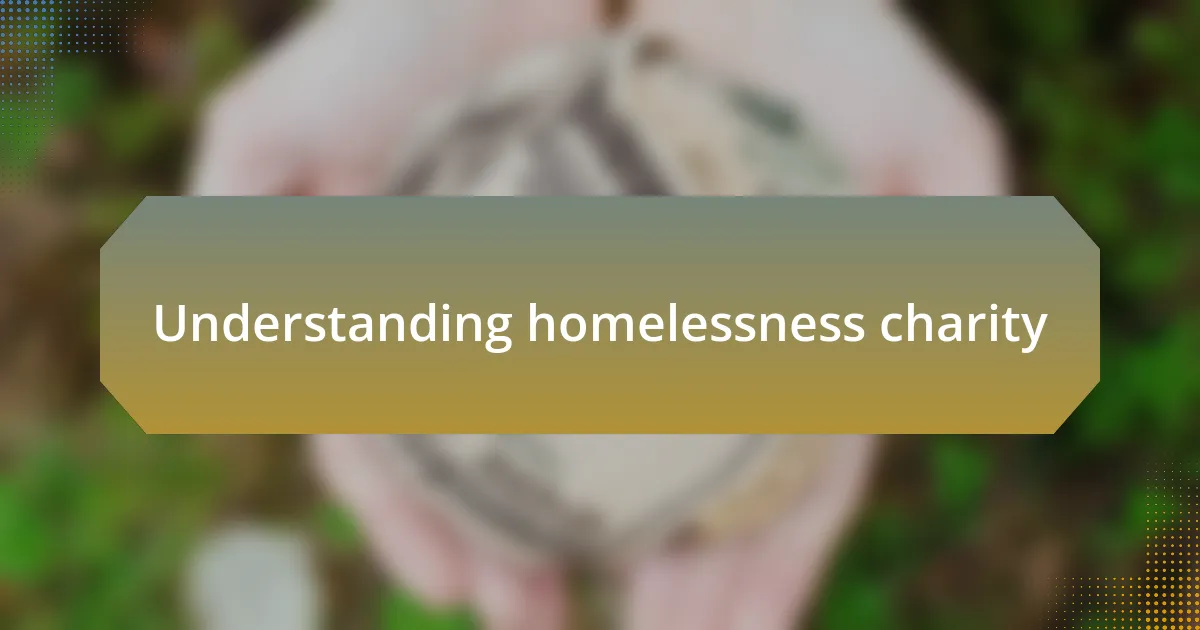
Understanding homelessness charity
Homelessness charity plays a crucial role in providing immediate assistance to those in need. I remember volunteering at a local shelter where I met individuals from all walks of life, each with a unique story that led them to seek help. It really struck me how easily someone can fall into homelessness, often due to circumstances beyond their control.
Many people think that homelessness is simply a matter of lack of housing, but I’ve learned it’s much more complex than that. Emotional and psychological factors, like mental health issues or substance abuse, often intertwine with financial instability. It makes you wonder: how many of us can truly claim that we’re just one or two bad days away from facing a similar fate?
Effective homelessness charities not only provide food and shelter but also address the underlying issues that contribute to homelessness. I once heard a former homeless man share how the support from a charity gave him the courage to seek therapy and rebuild his life. That’s the power of holistic solutions; they tackle poverty while fostering hope and resilience in individuals who have often lost both.
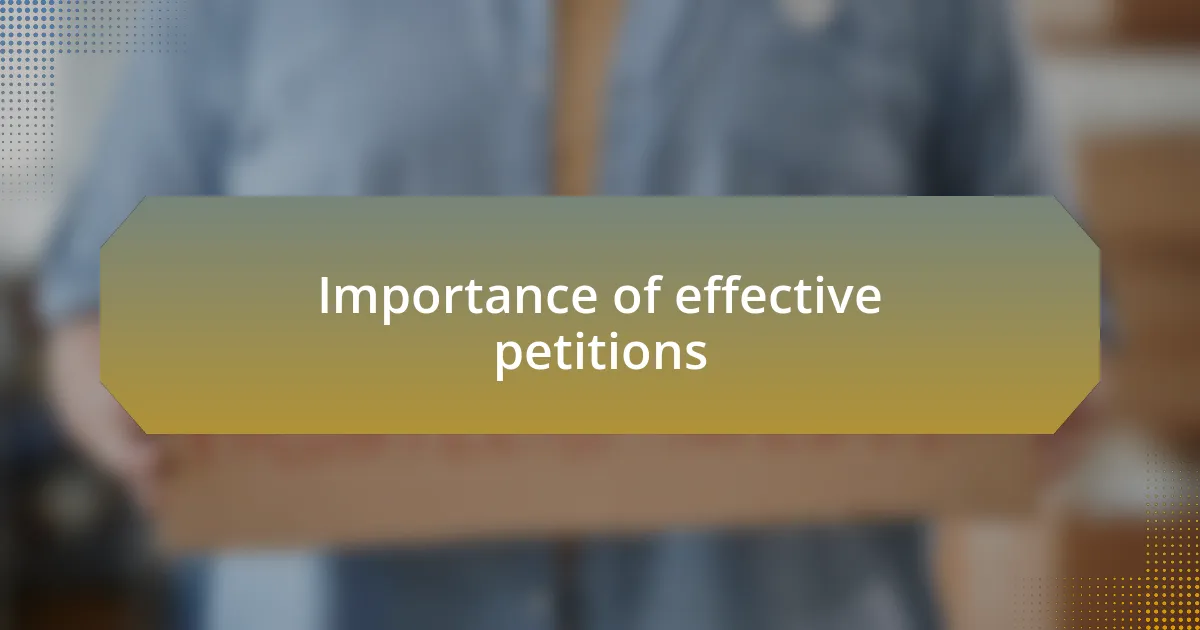
Importance of effective petitions
There’s no denying the significance of effective petitions in driving change within homelessness charities. I recall a time when a well-crafted petition gathered thousands of signatures, pressuring local officials to allocate more funds for shelters. This collective voice not only drew attention to the urgency of the issue but also demonstrated how united we can be in advocating for those who often feel voiceless.
Moreover, a successful petition can serve as a vital tool for raising awareness about the complexities of homelessness. When I helped organize a petition around mental health services for the homeless, it sparked conversations in our community that were previously avoided. What if every petition could do that, igniting dialogue and fostering understanding between supporters and skeptics alike? It’s exhilarating to think about the potential for change that lies in a few powerful words.
Ultimately, the success of petitions hinges on clarity and passion. I remember drafting one that outlined not just the dire statistics but also personal stories from those affected, which made the plea resonant on a deeper level. It reminded me that effective petitions can incite not just action, but empathy, compelling people to truly consider the humanity behind the statistics.
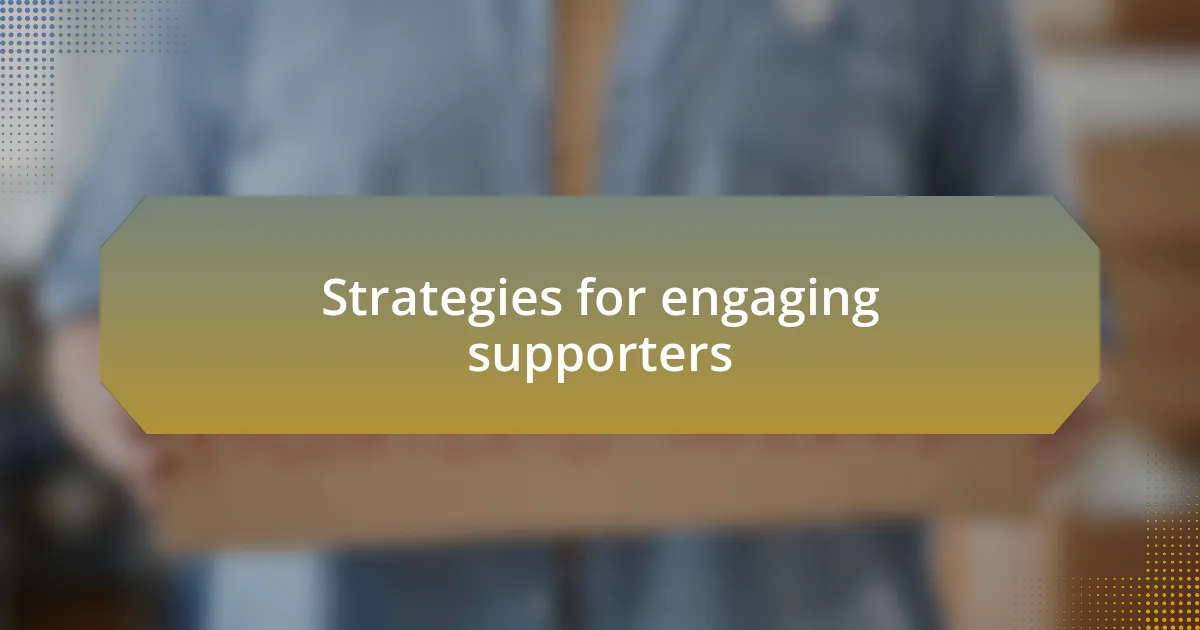
Strategies for engaging supporters
Engaging supporters is all about creating connections that resonate emotionally. I once reached out to a local artist to collaborate on a petition, incorporating her artwork to illustrate the plight of the homeless. This partnership not only made the petition visually impactful but also brought in her followers, turning them into supporters who were previously unaware of the issue. How often have we overlooked the idea of creativity as a bridge to engagement?
Another effective strategy I’ve found is storytelling. Sharing impactful narratives from individuals experiencing homelessness can be incredibly powerful. I vividly recall a moment at a community meeting where a young man shared his journey from homelessness to stability, and the room fell silent. People were visibly moved. It reinforced my belief that every supporter wants to feel a personal connection to the cause—after all, who doesn’t want to be part of something bigger than themselves?
Finally, consistency in communication is crucial for fostering ongoing support. I remember creating a monthly newsletter that not only updated our supporters on petition progress but also spotlighted dedicated volunteers and their efforts. This simple act of recognition transformed supporters into active participants. Have you ever wondered how a small gesture of appreciation can energize a community? It’s remarkable how engaged supporters become when they feel valued and acknowledged.
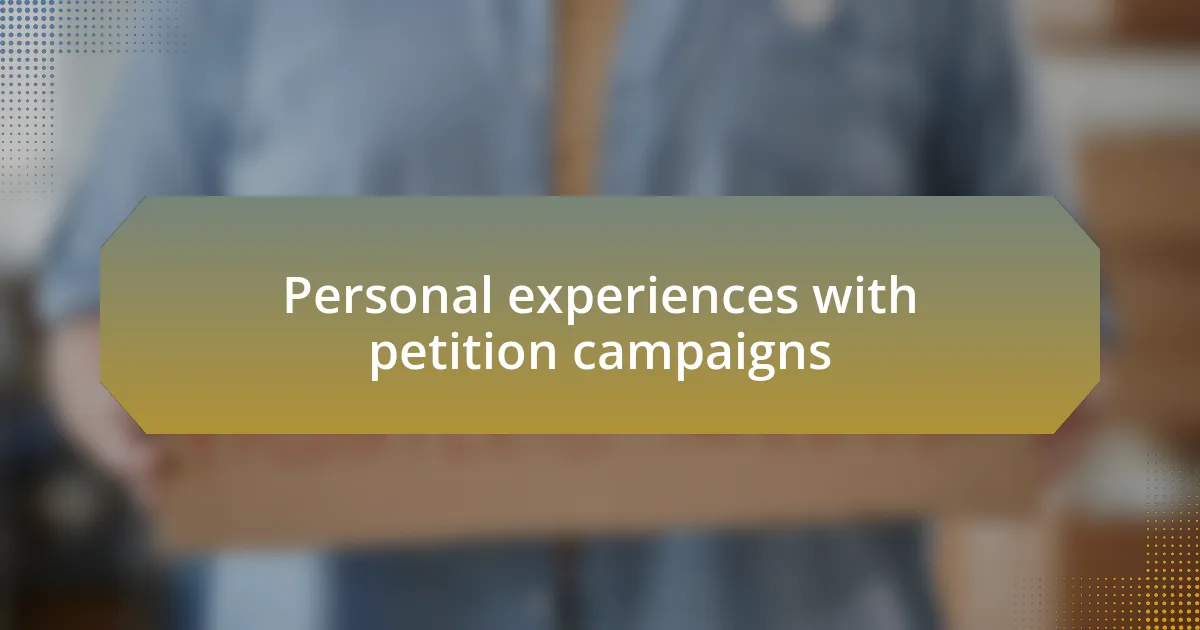
Personal experiences with petition campaigns
Throughout my journey with petition campaigns, I learned the power of personal connections firsthand. I remember standing outside a busy café with a clipboard, trying to gather signatures for a local initiative to support a homeless shelter. A woman paused, her eyes filled with compassion, and shared her own experiences with family homelessness. Coming together in that moment transformed the campaign; it was no longer just about numbers, but about real lives and shared struggles. How often do we underestimate the impact of personal stories in our outreach?
Another memorable experience occurred during a rally where we presented our petition to the city council. The anticipation was palpable, and I felt a mix of excitement and anxiety. As we presented, I noticed a council member’s expression soften when he heard a poignant story shared by a formerly homeless individual. That connection energizing the room resonated deeply with me. Have you ever felt that fire ignite when confronted by raw, honest narratives? It made me realize that authentic voices can influence decision-makers in ways mere statistics never could.
In one campaign, I organized a virtual town hall meeting aimed at discussing homelessness solutions. Participants ranged from seasoned activists to curious locals. I was genuinely moved by the willingness of people to share their insights, often reflecting their own fears and hopes. The dialogue became a powerful tool, driving not just signatures but fostering a sense of community commitment. Isn’t it fascinating how these interactions can evolve into a collective movement for change? These personal experiences have shaped my belief that engagement is intensely human, grounded in empathy and understanding.
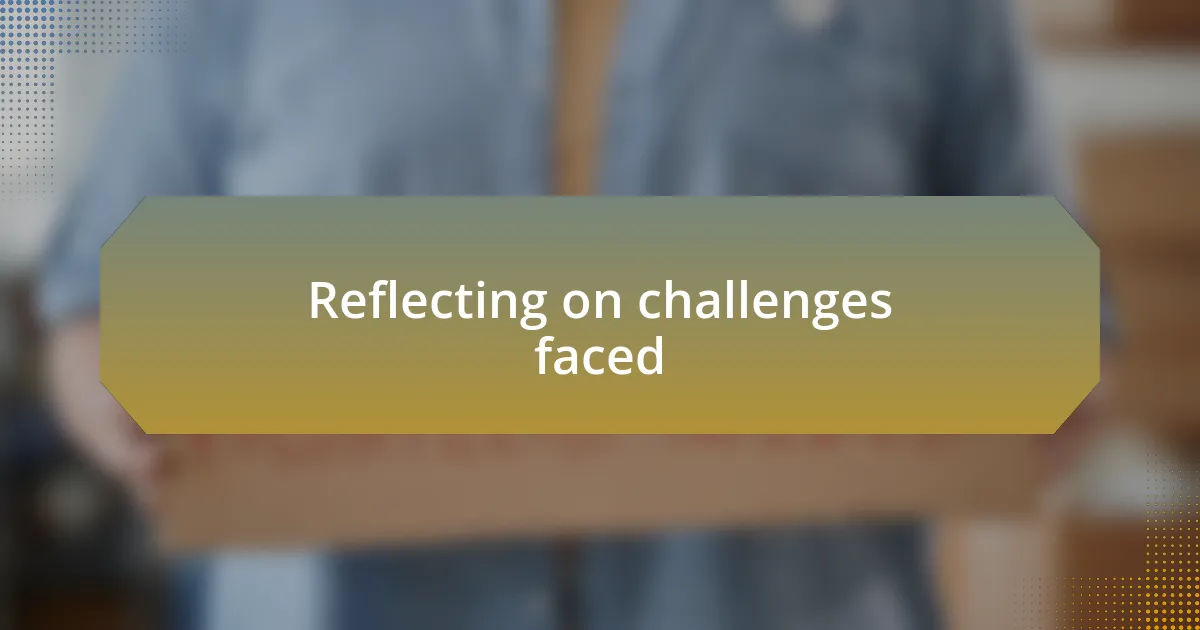
Reflecting on challenges faced
Engaging with petition campaigns isn’t without its challenges. I remember one particularly testing day when a cold rain poured down during a signature-gathering event. Many passersby hurried past, their faces a mix of indifference and ‘I can’t help right now.’ It struck me how easily our message could get lost in their busy lives. Have you ever tried connecting with someone when they’re overwhelmed? I sensed the uphill battle facing advocates in moments like this, reminding me of the relentless nature of raising awareness.
The resistance we sometimes encounter can be disheartening. I once approached a local business owner for support, only to be met with skepticism about how our petition would genuinely make a difference. The conversation left me questioning the effectiveness of our efforts and the perceptions surrounding homelessness. How do we break through that wall of doubt? In that moment, I realized the importance of not only presenting compelling facts but also sharing inspiring success stories that illustrate real change.
Another hurdle lies in maintaining momentum within our team. Early on in a campaign to push for better local shelters, our group faced fatigue as the relentless grind of outreach wore on. One evening, as we gathered in a dimly lit meeting room, I suggested sharing our ‘wins,’ no matter how small. This simple shift reinvigorated our spirits; celebrating even little victories reminded us of our purpose. Isn’t it amazing how a collective reflection on progress can reignite passion when times get tough?
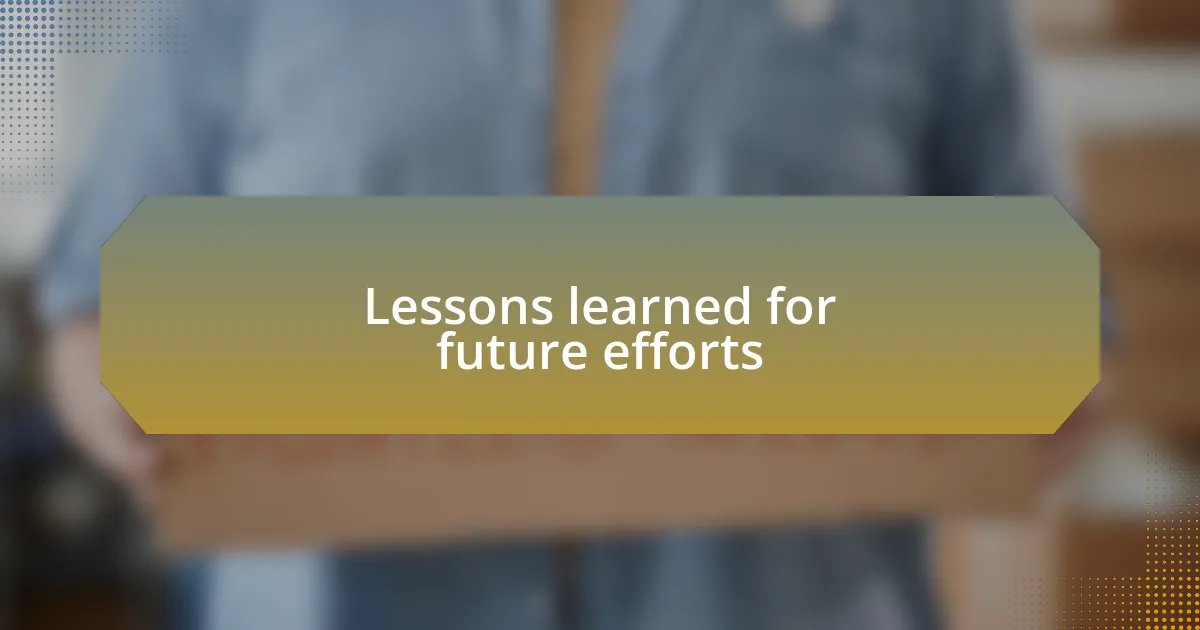
Lessons learned for future efforts
While reflecting on my experiences with petition efforts, one crucial lesson emerged: the power of storytelling. I remember a time when I shared a heartfelt account from a person who had benefited from our advocacy. It was a simple narrative, yet it shifted the atmosphere in the room. How can we expect others to care if we don’t humanize the issue? This realization highlighted how vital it is to craft narratives that connect emotionally, making the message resonate on a personal level.
Another key lesson centers on timing and consistency. During our campaigns, I found that we often launched petitions without considering the broader landscape or current events. For instance, I was surprised at how much more engagement we received when we coincided our efforts with a local homelessness awareness week. Have you ever noticed how timing can amplify a message? Being strategic about when we push for signatures can significantly impact our outreach’s effectiveness.
Lastly, I learned about the importance of collaboration. There was a moment when our team decided to partner with other local organizations for a joint petition. Initially, I was skeptical—would our voices blend together or get lost? But as we worked side by side, I felt a powerful synergy emerge. Collaboration not only widened our reach but also enriched our understanding of homelessness, as we learned from each other’s experiences. How often do we overlook the strength found in unity? This experience taught me that working together amplifies our efforts and gives a more comprehensive view of the issue we aim to address.